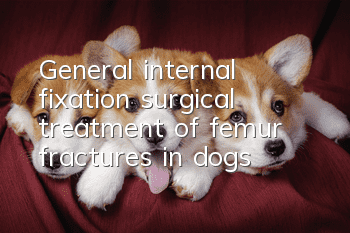General internal fixation surgical treatment of femur fractures in dogs

Injuries are common for aggressive dogs. The femur is located on the upper part of the hind limb and below the hip, and plays a vital role in supporting body weight and movement. The incidence of femoral fractures is high, including fractures of the femoral neck, greater trochanter, femoral shaft and distal femur. Femoral shaft fractures are common in adult animals, while shaft and femoral neck fractures are more common in young animals.
Dalmatian Dog
Symptoms: Femoral shaft fractures are often accompanied by displacement of the fracture fragment or broken end. The animal's affected limb is shortened and unwilling to move. The fracture site is swollen to varying degrees, especially in the medial femoral area. There is a feeling of bone friction during passive movement. When the femoral head is fractured, the animal can still bear partial weight on the affected limb. The lameness is not as serious as that of a diaphyseal fracture. Slight swelling can be seen in the hip and bone friction sounds can be heard.
1. Medical history:
A male Schnauzer, named Ruirui, is one year old, fully immunized and dewormed. Two days ago, his owner took him out to play and got into a fight with a big dog. After being bitten by the big dog, he walked with a limp and his body was damaged. No other external injuries were seen. The pet owner checked that there was no bleeding or wounds and did not do any further treatment. The next day, he found that the hind limbs were swollen and could not touch the ground and could not walk normally. Feeling that the situation was serious, he brought the pet to the hospital for examination.
2. Clinical examination:
The initial diagnosis revealed that the dog's right hind limb was dragged behind, unable to lift, and unwilling to move. Palpation revealed a fracture of the femoral shaft, a friction sound at the end of the bone, external swelling of the femoral shaft, and no damage to the skin. The dog had been eating normally and in good spirits since the injury. The condition is good, and it is no longer painful when palpated. A more detailed examination will be carried out to confirm the condition.
3. Imaging examination:
Based on the results of the above imaging examinations, it was diagnosed as a distal femoral shaft fracture, which cannot be cured by external fixation alone and requires surgical treatment. Based on the preoperative biochemical examination and overall physical assessment, the dog's preoperative score was level 2 (mild risk). It is recommended that pet owners choose inhalation anesthesia to reduce the risk of surgical anesthesia. Preoperative fluid infusion regulates fluid balance. Give atropine to stop bleeding.
4. Surgical process:
1.) Induction with Serta and then inhalation anesthesia for surgery.
2.) Baoding, hair preparation, disinfection, wound fixation, surgical isolation
3.) Cut the skin along the median of the femur on the right knee, cut the fascia, bluntly separate the vastus lateralis muscle and biceps femoris muscle along the direction of the muscle groove, and directly expose the fractured end of the femur. During the operation, be careful to stop bleeding and avoid damaging blood vessels.
4.) Clamp the two broken ends with bone-holding forceps, and the assistant pulls the right lower limb to try to restore the broken ends to normal and close together.
5.) Make sure that the broken ends of the fracture are basically aligned and then bite them with rongeurs. Select the appropriate bone plate and bone screws, drill holes in the bone, and implant the bone plate.
6.) Suture the periosteum, internal muscles and fascia with 0/3 catgut suture. Clean the wound and disinfect it.
7.) Use silk knots to suture the skin wound.
5. Postoperative care
1.) Try to limit the dog’s activities after surgery, and it is best to keep it in a cage
2.) Proper calcium supplementation after surgery to promote the formation of callus
3.) Wear an Elizabethan retaining ring after surgery to prevent the dog from licking the affected area.
4.) Routine anti-inflammation and analgesia for 3-5 days after surgery. The sutures will be removed after one week. Imaging examinations will be performed every month to observe the growth of the stump and gradually carry out rehabilitation training to prevent muscle atrophy and functional degradation.
5.) Review and remove the internal fixation plate after about three months, and remove the skin sutures after one week.
Discussion:1.) In the X-ray in the last picture, you can see that the broken ends of the fracture have been aligned, which basically achieves the expected treatment purpose.
2.) In this case, intramedullary pin fixation can also be used as the internal fixation method, and no wire assistance is required. Since it is a transverse fracture, it can be better fixed with a compression plate.
3.) The dog showed no infection or discomfort after returning, and the wound healed well. The affected limb can be put on the ground after 3 days.
- The dog doesn't sleep at night and walks back and forth. What's the reason why the dog doesn't sleep at night?
- How to treat urinary tract stones in dogs? Dogs may need surgery!
- What should I do if my dog has no milk? The owner should check quickly and don’t let the puppies starve to death.
- Dog’s anal gland odor, please note that this is a sign of your dog’s health!
- What are the symptoms of dog pain? How to detect dog pain early
- How to make your dog like to eat dog food Four ways to make your dog fall in love with dog food
- Can dogs digest peach pits if they eat them? Can dogs digest peach pits if they accidentally eat them?
- How to protect your dog’s food? Teach you tips on training your dog
- Why do dogs defecate everywhere? How can dogs stop defecating everywhere?
- What should I do if my dog has lupus? Immune system diseases should not be underestimated



